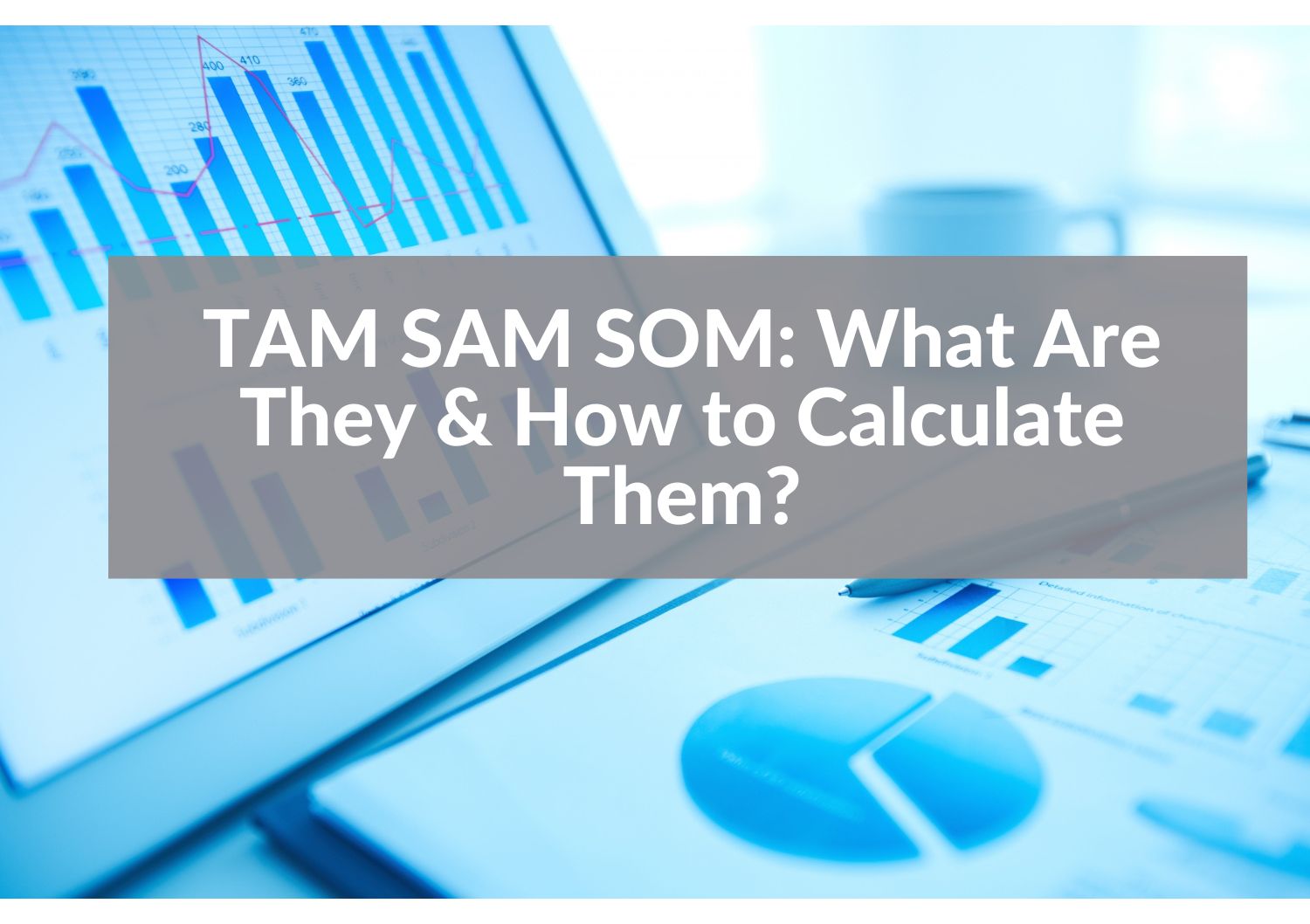TAM SAM SOM: What are They? Why are They Important in a Business Plan?
Table of Contents
- TAM SAM SOM: Definitions & What are they?
- Looking for a Market Research Analyst?
- TAM: TAM stands for ” Total Available Market”
- Total Addressable Market vs Market share
- How to calculate Tam?
- Want to write a business plan?
- SAM: SAM stands for "Serviceable Addressable Market"
- How To Calculate Sam?
- SOM: SOM stands for “Serviceable Obtainable Market “
- How To Calculate SOM?
- TAM SAM SOM Example:
- TAM SAM SOM: Why are they important in a business plan?
- FAQs:

TAM, SAM, and SOM are business metrics that help investors evaluate a market. Before getting into the industry, Investors need to properly analyze the market and understand its potential revenue.
Different businesses have different market sizes. Assessing a market, potential customers, and revenue minimizes the risk of business failure. A successful business plan contains these three metrics to attract investors for fundraising.
TAM SAM SOM: Definitions & What are they?
TAM, SAM, and SOM are acronyms that are well recognized among the business community. These metrics are an important part of every business plan.
If you want to start your business, the first step is to examine the market. To convince an investor, you will need to put TAM, SAM, and SOM figures into your business pitch.
This will help you to understand the market’s worth. TAM, SAM, and SOM give an idea about the market share that you can get.
You can calculate your ROI after having a clear idea of TAM, SAM, and SOM.

Looking for a Market Research Analyst?
Hire a market research analyst from Wise Business Plans to get professionally sourced and curated market research.
TAM: TAM stands for ” Total Available Market”
“TAM {Total addressable market} is a term that is used to define the total revenue opportunity for a product or service”
TAM describes the total demand for a product, and service in the market.
TAM evaluates the market potential, and revenue a business can make in a certain market. It explains who are the potential customers of a specific product.
Example:
Let’s understand the potential of the coffee business. You want to start a coffee business. The first step is to analyze the TAM.
The number of people who love coffee will be included in the TAM.
It doesn’t matter whether you can serve those people or not. TAM only demonstrates the total market of a specific product.
Total Addressable Market vs Market share
If you have a monopoly in a specific market, you will have a total share of that Market.
Example :
Let’s suppose you want to start a coffee shop. The first phase will be to examine the Market.
How many sales can a coffee business generate? Who will be the potential customers to buy the coffee? If you are the sole coffee shop owner in the market, you’ll have a monopoly. It means you share 100% of the market.
Customers won’t have any other choice except to buy your coffee. In this case, you’ll have a total addressable market.
But if you gain a competitor, you will have to split the TAM. If you have too many competitors, TAM will be split into many competitors. It means you will have a small market share. That is called a share Market.
How to calculate Tam?
There are three ways to calculate Tam.
- Top-down: In the first method, businesses use industry data, reports, and research studies to analyze their Tam. As these research data are not up to date, businesses need to hire consulting firms to conduct fresh research on their behalf.
- Bottom-up: This method collects data from the previous sales, and gives an accurate assessment of the Total addressable market.
Example:
Let’s understand it through a real-life example. You sell coffee in New York. You sell an average of 100 cups of coffee daily at the cost of $20 per cup.
100×20 = 2000
2000 is the annual contract value. Now, calculate TAM.
Suppose there are 1000 customers. No matter whether you can sell your coffee to them or not.
2000×1000 = 2m
The total available market is 2m.
This is how Tam will be calculated.

Want to write a business plan?
Hire WiseBusinessPlans’ professional business plan writers anytime!
- Value theory: Value theory depends on the value of your product. If your product gives some extra value to your customers compared to the products of your competitor, your product can be sold at a higher rate.
You can calculate your value theory by analyzing how much your customers are willing to pay for your superior product.Example:
Generally, you sell your coffee at the cost of $20 per cup. You introduced a new coffee flavor which is better than the previous one. Your customer might love this new innovative coffee.
You added value to your ordinary coffee. Now, you can increase the price and can sell your coffee at the cost of $25 per cup.
Before increasing the price, you need to make sure that your customers are actually willing to buy your coffee at a higher rate.
After calculating TAM, the next step will be to dive deep into the industry.
Access our free business plan examples now!
SAM: SAM stands for "Serviceable Addressable Market"
SAM {Serviceable Addressable Market } is the part of TAM that can actually be reached.
TAM illustrates the market potential. SAM gives an estimate of the target audience that will buy a product. SAM describes the area of TAM to whom you can sell your product.
It answers the question about which geographical area of TAM is best to target to sell goods or services.
If businesses understand their serviceable addressable market, they are more likely to generate sales. Businesses can run their marketing campaign in a better way after analyzing Sam.
Example:
Let’s continue with the coffee example again. You have a coffee shop in a city. Your SAM is the total number of people residing in this city.
You can not serve all the population. It only gives an idea about the potential. However, if you expand your business, and open more coffee shops in the city, you can possibly reach out to more customers.
How To Calculate Sam?
For measuring the Serviceable Market, it is required to exclude the region or specific area of the market that a business can’t serve.
If a business is unable to get customers from a specific geographical area of a market, it is worth doing to exclude it. If a product is a misfit for some segment of a market, companies try to exclude that segment.
Companies can estimate SAM if they exclude unnecessary geographical regions from a market.
TAM is the total market whereas Sam is a segment of the market that will be a good fit for your business.
Calculation Formula:
SAM = The Target Segment of TAM x Annual Contract Value
If a target segment is 3000 of the Total market (6000) , and the Annual contract value is $1000, the SAM will be $300000.
After evaluating SAM, businesses serve better in their segment of the Market.
SOM: SOM stands for “Serviceable Obtainable Market “
“SOM {Serviceable Obtainable Market} means a market share that a company can get realistically”
“SOM {Serviceable Obtainable Market} means a market share that a company can get realistically”
TAM gives companies an idea about the market potential. Sam helps businesses analyze a specific part or area of the Market.
SOM which is called the serviceable obtainable market provides an estimate of the people who are willing to buy the product or service.
It is a sub-branch of Sam that enables the business to perform well in its specific niche. SOM assists the companies to get an idea about what part of SAM will perform well for their business.
SOM will contain only those consumers that will buy products. It means targeting a very specific area of the market to reach your business goal.
Example:
You have a coffee shop in a small town. You can serve the population of that small town. You can exclude the segment which you can not serve. If you can offer coffee to 300 people in the town, those people will be your potential customers.
How To Calculate SOM?
SOM gives the most realistic idea about the customers and chances of growth of the business.
Calculation Formula:
SOM = Last year’s market share x this year’s SAM
Example:
Let’s suppose last year’s market share was 10% and this year’s SAM is 5 million, this year SOM will be around $500000.
This straightforward formula gives an exact number of your SOM.
TAM SAM SOM Example:
Let’s suppose you want to open your coffee shop in New York.
You’ll examine the total average revenue of coffee shops located in New York.
The total average revenue figure is $2000m. $2000 describes the TAM of the coffee business in New York.
The next step is to examine the SAM of the coffee business. You want your coffee shop in a small town in New York.
Coffee shops in that small town only get 20℅ of the Total market which is 400m.
Now, it’s time to get SOM. There are 100 shops in that small town.
400m/ 100 = 4 million
The average SOM is around 2 million. In this way, you can get an idea of TAM, SAM, and SOM of any business.
TAM SAM SOM: Why are they important in a business plan?
TAM, SAM, and SOM are metrics that are used to analyze market size and potential.
If you are starting your own business or you want to convince an investor for funding, it is necessary to have a calculation of TAM, SAM, and SOM along with a concrete business proposal.
Evaluating the market before getting it started helps investors stay out of the danger zone of failure. It minimizes the risk of losing investment.
TAM, SAM, and SOM help businesses create a solid business plan to work on. For businesses, these three metrics can be considered as three stages. Start-ups will focus on SOM to reach their goal. If a business can’t reach SOM, it may not be able to capture a global market.
By understanding TAM, SAM, and SOM, you can put a strong proposal in front of your investors with maximum ROI. These metrics provide an idea of whether it is worth investing in a certain market or not.
Get WiseBusinessPlans’ Business Plan Writing Service Now!
FAQs:
TAM stands for Total Addressable Market. It represents the total market demand for a product or service, without considering any limitations or constraints.
SAM stands for Serviceable Addressable Market. It represents the portion of the TAM that a business can realistically target and serve based on its capabilities, resources, and market positioning.
SOM stands for Serviceable Obtainable Market. It represents the portion of the SAM that a business can realistically capture or obtain based on its marketing efforts, competitive landscape, and market share goals.
TAM, SAM, and SOM are important in a business plan because they provide a clear understanding of the market size, the business’s potential target audience, and the achievable market share. They help in evaluating market opportunities, setting realistic goals, and developing effective marketing and growth strategies.
Determining TAM, SAM, and SOM involves conducting market research, analyzing industry data, and segmenting the market based on relevant factors such as demographics, geography, and customer needs. This information helps businesses estimate the market size, identify their target audience, and define their obtainable market share.

